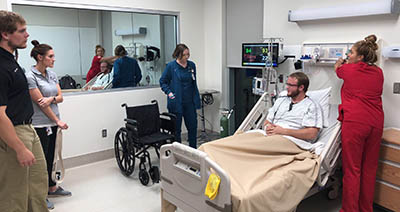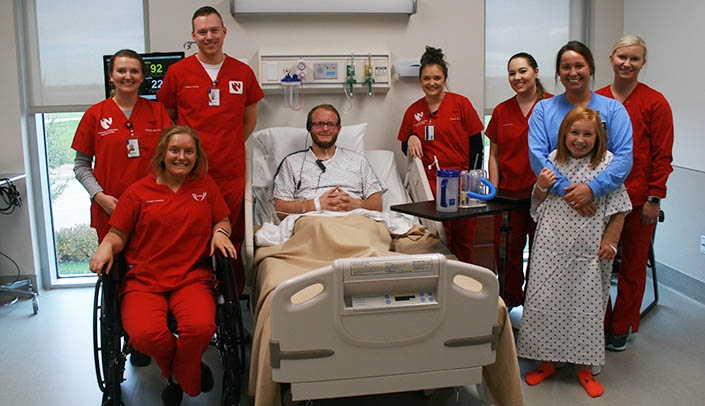Simulation helps students hone their skills, as well as learn about the roles other health care disciplines play in patient care.
Senior nursing students in Kearney recently had the opportunity to teach radiography and physical therapy students about nursing’s roles in patient care.
 |
Nursing student Bayley Gardner (far right), demonstrates how nurses transfer the oxygen supply from the wall to a portable tank. Left to right are Colton Walker and Samantha Sattler, physical therapy students; Hope Dillman, radiography student; and Samuel Backer, nursing student. |
Nursing student Summer Orender learned two important lessons from the simulated task.
“It’s important to assess what the other professions already know about what we do and also to consider the language used to teach another profession,” she said. “Medical jargon is a huge issue when communicating with other professions and even patients at times. We will be better nurses because of this experience.”
Heather Kaestner, an instructor at the UNMC College of Nursing Kearney Division, said clinical simulation makes the transition from the classroom to the clinic less daunting.
“We get students to work on communication and expose them to what it will be like in the real world so they know what they’re doing and what’s best for the patient,” Kaestner said. “One of the ideas the nursing students wanted to emphasize — don’t be afraid to go find a nurse when you have a question about the patient.”
Tessa Wells, D.P.T., an assistant professor of the Division of Physical Therapy Education, UNMC College of Allied Health Professions in Kearney, said the unique inclusion of a pediatric “patient” was excellent. “I am pleased to say the students did a great job, and learned how to engage the child as well as confirm pertinent information from the parent.
“Several students said they really appreciated being able to get into an acute care environment and be exposed to the use of gait belts, hospital beds, monitors and lines/tubes to be mindful of when helping their patients to move,” Dr. Wells said. “This continues to be a valuable experience and gives students increased confidence in their skills.”

What a really nice idea. Congratulations to Nursing and Allied Health in Kearney to put this together.